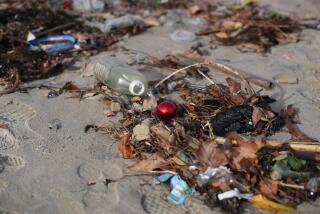Fat kids, Time’s national shame
- Share via
Today’s question: The Centers for Disease Control and Prevention says the growth of childhood obesity has leveled off, yet Time magazine just devoted a special issue to tubby tots. Is this a growing problem or just a moral panic? Kerry Howley and Kay Hymowitz debate the politics of children. Yesterday, they discussed the teen pregnancy pact. Later this week, they’ll discuss fertility rates and other topics.
Say no to Wild Bubble Berry Pop-Tarts
Point: Kerry Howley
Kay,
As with the teen pregnancy rates we discussed yesterday, child obesity rates have shifted dramatically over the last two decades -- but this trend line has been moving in the wrong direction. Given the risks of Type II diabetes, it’s a problem that about 19% of 6- to 11-year-olds are obese. We can blame adults who make themselves sick Morgan-Spurlock-style, but you can’t hold a 7-year-old responsible for Coke-and-Frito dinners.
It’s tempting to blame marketers who sit around dreaming up ads for SpongeBob SquarePants Wild Bubble Berry Pop-Tarts -- and I fear the mind that developed that product -- but kids probably absorb fewer food-related advertisements than they did before obesity was deemed an “epidemic.” According to research by George Mason University law and economics scholar Todd Zywicki [pdf], kids’ exposure to such advertisements has either remained constant or declined over the last 15 years. Either Cookie Crisp commercials have become miraculously more effective over time, or kids are expanding for other reasons.
Parents are obviously suspect here, but accusing them won’t do much to help the kids they’re overfeeding. I’m supportive of targeted interventions in school districts where the problem is worst, most of which are in the South and Southern parts of the Midwest. (Public school kids in Boulder, Colo., don’t seem much in need of dietary advice.) There is no defensible reason to serve pizza and Tater Tots in school lunch rooms, which I recall as a highly anticipated offering in my elementary school cafeteria.
Because there is evidence that the increases in child obesity are mostly due to a decrease in exercise rather than an increase in caloric intake, perhaps public schools ought to put the focus on getting outside. (If daily physical education classes have a notable effect, I’m all for them, though my memories of P.E. generally involve waiting motionless in the outfield for a ball to come my way. We may have also watched some educational films about the benefits of physical activity.)
That said, Time’s cover story -- which manages to disappoint from the cover line onward -- gets a little too excited about the threat of giant children. “There is no way to overestimate how scary numbers like this are,” a scientist tells journalist Jeffrey Kluger. Um, actually there is -- and there are reasons to wonder whether some programs, such as weighing kids at school and sending them home with “fitness report cards,” might do more harm than good. As my colleague Radley Balko has pointed out, kids under 18 are far more likely to suffer from eating disorders than they are from Type II diabetes. Stigmatization -- while perhaps less frightening than SpongeBob Pop-Tarts -- comes with its own dangers.
Kerry Howley is a senior editor at Reason magazine.
Nagging children long to eat garbage
Counterpoint: Kay Hymowitz
I agree with a lot of what you say about childhood obesity, though I would give parents more grief than you do. The schools shouldn’t be let off the hook, of course. Ketchup is not a vegetable, and if we’re being honest, neither are fries. And whose brilliant idea was it to cancel recess? According to a widely cited study, 40% of schools are either planning or have already cut out this supposed waste of children’s time.
Still, kids do most of their eating and non-exercising outside of school hours, when parents are in charge. (Also, doctors are seeing an awful lot of fat 2-year-olds, who haven’t yet had the pleasure of cafeteria lunches.)
Granted, parents don’t have it easy today. Remember that obesity is an artifact of contemporary affluence. I don’t mean you have to be rich to be fat; on the contrary, rates of childhood obesity are highest in poor rural areas and among minority kids. But the abundance of cheap, processed and pre-prepared food is something new in human history. Even I’m old enough to remember when you didn’t walk down the street -- or through the mall -- and spy temptation with every step.
Today, in order to teach self-control -- one of the key things parents do -- they either have to blindfold their kids or prepare for psy-ops every time they leave the house. Can I have (pick your poison): ice cream, pizza, potato chips, Gummi Bears? Can I have a big Whopper for dinner? A Coke for breakfast? If you do, I’ll walk the dog. If you don’t, I’ll throw myself on the ground and hold my breath. Puhlease!?
It makes no sense to blame Big Soda or Big Burger for this state of affairs. They’re simply producing what people -- mostly adults, by the way -- want to buy. I suppose you could ban TV advertising directed at younger children as the Swedes and Norwegians have done. But these days, television is just a drop in the marketing ocean. My kids rarely watched television, but every trip to the supermarket or drug store meant war. What kept them at a reasonable weight were good genes -- a gift not to be underestimated -- and a heartless mother.
Still I agree, despite the genuine health concerns, that childhood obesity has prompted too much heavy breathing. Did Newsweek really think it necessary to repeat the phrase “the terrorist threat from within?” Did Time need to put a kid so gross he could have amused Diane Arbus on its cover? Let’s not forget: Obesity is not just for kids. In a neat but depressing irony, Mike Petrilli of the Fordham Foundation has estimated that overweight teachers are costing schools $2.5 billion annually in healthcare costs. Somehow, I doubt that’s because they’ve been eating at the school cafeteria.
Kay Hymowitz is a senior fellow at the Manhattan Institute and contributing editor of City Journal. Her most recent book is “Marriage and Caste in America: Separate and Unequal Families in a Post Marital Age.”
| Day 2 | | |
More to Read
A cure for the common opinion
Get thought-provoking perspectives with our weekly newsletter.
You may occasionally receive promotional content from the Los Angeles Times.










